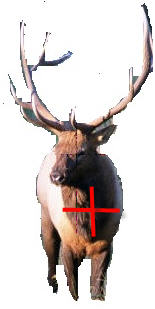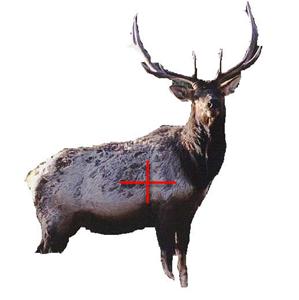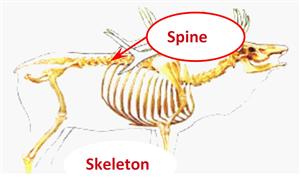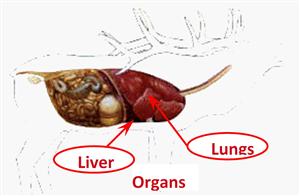Shot Placement - Rifle and Black Powder
By Jim Roode
 Over the past year or so, we have had a number of questions by the students at EHU concerning the best shot placement for a large animal such as an elk. Most hunters intuitively know a quick, humane kill will follow a shot placed the heart-lung area. Then they get in the field and have to judge exactly where that heart-lung area is located on the animal and in the excitement of the moment, may make poor decisions resulting in a wounded or lost animal. It is difficult as a writer to portray all of the possible scenarios that will occur in the field when hunting elk. Most hunters in Colorado do not hunt elk from a tree stand, ground blind or other fixed structure. We stalk, still-hunt, or sit on a likely meadow or crossing point where we expect the elk to traverse when moving from a bedding area to a feeding area. Perhaps the best way to describe proper shot placement with a rifle or muzzleloader is to provide you with a short scenario and some of the questions that run thorough your mind. Follow along as we discuss a scenario that presents some shot-placement considerations.
Over the past year or so, we have had a number of questions by the students at EHU concerning the best shot placement for a large animal such as an elk. Most hunters intuitively know a quick, humane kill will follow a shot placed the heart-lung area. Then they get in the field and have to judge exactly where that heart-lung area is located on the animal and in the excitement of the moment, may make poor decisions resulting in a wounded or lost animal. It is difficult as a writer to portray all of the possible scenarios that will occur in the field when hunting elk. Most hunters in Colorado do not hunt elk from a tree stand, ground blind or other fixed structure. We stalk, still-hunt, or sit on a likely meadow or crossing point where we expect the elk to traverse when moving from a bedding area to a feeding area. Perhaps the best way to describe proper shot placement with a rifle or muzzleloader is to provide you with a short scenario and some of the questions that run thorough your mind. Follow along as we discuss a scenario that presents some shot-placement considerations.
150 Yards
So you've been sitting near a spot where two game trails cross. One trail parallels the ridge line about 10 yards below the top. The second trail crosses a nice saddle in the ridge. At about 4 p.m., you spot a bull elk at 150 yards. You've got several decisions to make:
Do I want this elk?
Can the animal be easily processed and returned to camp?
What are the chances I will be prematurely detected (scent or sight)?
In the mountains, air generally flows down slope in the morning and rises in the afternoon. This elk is downhill, so chances are it won't smell you.
Although you're wearing blaze orange, if you're somewhat concealed and don't move, chances are the elk won't see you either.
Is my shooting position good enough to insure a good clean, one-shot harvest?
At what angle will the animal be presented and where will I aim? That is the crux of this article. To answer the question, we must decide where the elk is vulnerable and why. The pictures and table at the end of the article will help you consider the possible answers.
 140 Yards out
140 Yards out
The bull turns and walks uphill toward you, presenting a straight-on or slightly "quartering toward" shot. This is a low-percentage shot as only the heart and liver are vulnerable. Two lungs are not possible from this angle.
125 Yards
The elk keeps coming and crosses a short bench. Because of your elevation, the entire top of his back - and therefore his spine - is exposed. This could be a potential shot. He is walking directly toward you; there is no question as to the exact location of the spine. If you have a really good shooting position and could stop him by use of a cow call, you might be tempted to consider this shot. The aiming point would be center of the back at the point where the bullet might also intersect the spine or the heart. The target is still the spine but a little redundancy is not a bad thing.
This is a shot you should pass up. There are too many variables in this scenario. The elk is still coming on, closing the gap with each step. He doesn't know you're there. The optimum conditions for success are not yet present but in just a few more yards, the elk may present you with the perfect broadside shot. Patience is a virtue and will usually be rewarded.
 80 Yards
80 Yards
Another 40 yards and the elk pauses, quartering toward you at about a 45 degree angle. This is the first good opportunity for a shot since you saw him on the bench over 100 yards away. This is a shot which the cartridge and bullet play a role in the decision to shoot or not.
A light caliber rifle and light grained bullet are not a good combination for this shot decision. The front shoulder bones of an elk are large and dense and can stop or deflect a bullet of lesser size and velocity. With muzzle loaders, a round ball or any load that develops less than 1500 ftlbs of energy is questionable as well. To put a bullet into his vitals, you'll need enough bullet to punch through the shoulder with enough energy to inflict a fatal wound. This is something that ought to be left to the larger-caliber rifles and heavier-grained bullets.
The aiming point here is the front of the front shoulder, center of the body. The target is a little smaller than a broadside shot but if you've got the right cartridge and bullet, put in your practice time, have secured a good shooting position, a well-placed shot should result in a hit on both lungs and the bull on the ground.
On the other hand, busting up the shoulder will create a lot of bone-damaged meat. The elk still doesn't know you're there. In a few more steps, you may get a perfect broadside shot, or at least one where the elk's vitals are more exposed.
 50 Yards
50 Yards
Now the elk starts ascending a rather steep narrow section of the trail.
You can hear hooves, see the slight jerk in his head with each step. If you can hear him, he can certainly hear you. A savvy hunter will have his cow call at the ready. You issue a couple of soft chirps and he pulls up in an almost perfect, broadside position. Settle your cross hairs at the back edge of the shoulder, in the middle of the body. Exhale and gently squeeze the trigger.
We've talked a lot in EHU about having enough gun when hunting elk. If you get an elk in this scenario, broadside and motionless at 50 yards, even a .270 or .243 will do the job. If you've got something like my .45-70 on your shoulder, the likelihood of a clean kill is very high.
The shot echoes in the draw. The bull takes single jump and he is down. Wait. Replace the expended cartridge and watch the elk carefully for any movement. Stay alert for a follow-up shot. When you're confident the elk isn't going to jump up, approach carefully while watching for any signs of life. When you get around to the front, observe the eyes: are they open, unmoving, and unblinking? Take a couple of minutes to admire him; to say a word of thanks for having been given this opportunity and the skills to produce a clean and humane harvest. Now your license comes out and the carcass tag on it is torn off, filled out signed and returned to the wallet. A few minutes ago this bull belonged to everybody. Now it is your responsibility to process, share and enjoy this gift.
The scenario above is the “perfect” scenario we all hope to see in the field. Remember I said the word patience several times? I think far too often we tell ourselves a marginal shot is a good one rather than letting the full scenario play itself out. Far too often, we do not work hard at our shooting skills and are willing to take shots at angles and distances we are unsure of and make a bad decision and take a shot that we would like to have back after the shot is fired. The decision process in the scenario can teach the reader several things, first is patience: let the scenario play out for a bit. Second, develop the ability to clearly see the shot placement and know how the bullet will enter the elk and where it will intersect the vital areas. Third, make the decision to pull the trigger in a deliberate manner.
 We also need to discuss "quartering away" and moving straight away shots. Quartering away at more than a 45-degree angle can be almost as good as broadside. The target is getting narrower as the angle increases but no big bones are nearby to stop or deflect bullets. The aiming point is the off side front leg. At an angle less than 45 degrees, the target area is too small and a successful shot must necessarily pass through the stomach - thus contaminating much of the meat in proximity to the wound channel. If the shot is off, even a few inches, it could result in a complete miss of the vital area.
We also need to discuss "quartering away" and moving straight away shots. Quartering away at more than a 45-degree angle can be almost as good as broadside. The target is getting narrower as the angle increases but no big bones are nearby to stop or deflect bullets. The aiming point is the off side front leg. At an angle less than 45 degrees, the target area is too small and a successful shot must necessarily pass through the stomach - thus contaminating much of the meat in proximity to the wound channel. If the shot is off, even a few inches, it could result in a complete miss of the vital area.
A shot taken with the elk moving straight away from the hunter is a poor shot choice and will rarely result in a successful harvest. The bullet entering from the stern must travel too far to create fatal damage in the heart-lung area on an elk. The target area is too small and even at a close range, will probably result in a wounded elk.
The chart below is provided as an effort to give the reader a few concepts on shot placement decisions. You will note the heart/lung area provides the most reliable shot placement location and the largest “target area.” The heart/lung area for a bull elk is roughly 25 inches across, allowing for some error in shooting skills and still providing good shot placement. The other locations are small in size and failure to have an “exact” shot placement may result in a wounded animal.
Elk Vitals



Shot Location |
Fatal? |
Incapacitating/Time |
Comment |
Double-Lung | Yes | 0 to 10 seconds | The most reliable way to insure minimum travel. |
Heart | Yes | 0 to 1 minute | Always fatal but an elk can travel several hundred yards in a minute. |
Spine | Yes | Instant | A spine shot instantly paralyzes everything to the rear of the impact. If the shot is in the neck, death is also instantaneous. The spine is a very small target: not recommended for primary point of aim. |
Brain | Yes | Instant | The brain is a small organ on the end of three feet of bobbing and weaving neck, protected by large amounts of bone and horn. Under most circumstances it should not be considered a target. |
Arteries | Maybe | 5 minutes to not fatal | Bleeding contributes to debilitation. Arteries are more important for the archer to find with his broadhead. |
Liver | Yes | Minutes to several hours | If that was your shot, sit down, wait two hours and get ready for a long tracking session. |
1 Lung | No | Hours, if at all | A single lung shot by itself will not bring down an elk. |
Stomach | Maybe | Hours to days | A gut-shot elk can go a long, long way. |
Legs | No | Not | An elk can go a long ways very fast on three legs. |
To sum up, a good ethical hunter strives for a clean, quick and humane one-shot harvest. For me, that means I don't shoot if I am not 99.99 percent sure that pulling the trigger will result in a humane harvest. As your skills and success increase, patience and good ethics will become easier.
Good Luck, Practice your shots, and know your own limits.

